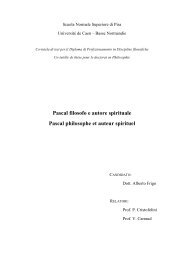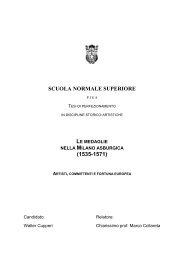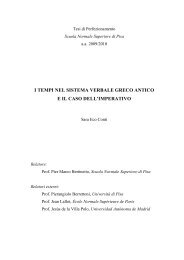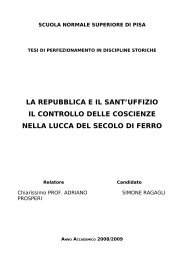CATULLUS 68 - Scuola Normale Superiore
CATULLUS 68 - Scuola Normale Superiore
CATULLUS 68 - Scuola Normale Superiore
Create successful ePaper yourself
Turn your PDF publications into a flip-book with our unique Google optimized e-Paper software.
daughter Tullia (Erskine 1997). Cicero tried to overcome his grief; here Manlius takes the Epicurean line and<br />
tries to console himself with alternative sources of pleasure.<br />
hoc ... epistolium ‘This little letter’. epistolium is the Latinized version of the Greek ⁄πι!τ〉λιον (see LSJ<br />
s.v.), the post-classical but not too rare diminutive of ⁄πι!τολ→. epistola, which was well-established in<br />
Latin by Catullus’ time, had no Latin diminutive. The imported Greek diminutive epistolium is found first<br />
here and does not re-appear until Apuleius, Apol. 6 & 79. Later Hilarius op. hist. fragm. 2.13 writes epistolia,<br />
id est litteras communicatorias and the Glossae Graeco-Latinae 84 v .19 equate the word with ⁄πι!τ〉λιον.<br />
While Apuleius could well have taken the word from Catullus, this can hardly be said of Hilarius, and one<br />
should note the use of ⁄πι!τ〉λιον in a work by that highly Hellenized Roman, the Emperor Marcus Aurelius<br />
(1.7.5): the Greek diminutive may have been well-established in vulgar Latin. Greek words and expressions<br />
appear regularly in Cicero’s letters to Atticus (which is the most informal part of his correspondence) and in<br />
Lucilius’ Satires, and they are used often by Petronius’ freedmen: many Romans must have been as bilingual<br />
in their speech as they were in their culture. In Catullus it is notable that while he does not use Grecisms too<br />
frequently, they often appear in a conversational context, where he is addressing someone: compare 12.3<br />
mnemosynum (a hapax in Latin), 16.2 pathice and 57.2 pathico (the word is found again in Martial and<br />
Juvenal and frequently in Pompeian graffitti), 22.5 palimpsesto (also in Cic. Fam.), 25.7 catagraphos<br />
(another hapax), 98.4 crepidas … carpatinas (carpatinus is a hapax but crepida is found in Cic. Rab. Post.<br />
and regularly afterwards), and perhaps even 64.154 leaena (also found in Varro L.L. and Cic. Glor.).<br />
Here epistolium has the advantage of fitting more easily into an elegiac couplet than the iambic epistolam.<br />
However, the author’s liking for diminutives is well known (see Riese xxv). Here the dimimutive may have<br />
emphasized the brevity of Manlius’ letter, it may have been used in an emotive sense (cf. Coleman 1999: 60)<br />
to emphasize Catullus’ affectionate feelings towards Manlius, or even to express pity (thus Cic. Att. 2.23.1<br />
recreandae uoculae causa, translated by Shackleton Bailey as “to refresh my poor voice”). In Greek, at any<br />
rate, ⁄πι!τ〉λιον need not mean more than ‘a letter’ (thus at M. Aur. 1.7.5).<br />
Trappes-Lomax (2007: 228) suggests that the word should be written as epistolion, as “it is an exotic import<br />
from Greek” and a poet as learned as Catullus could be expected to have retained the original spelling.<br />
However, this is unlikely if, as seems possible, epistolium was already circulating as a loan-word – and Latin<br />
appears to have converted Greek diminutives in –ion quickly into –ium (note that this has happened to all<br />
Plautine characters whose names were originally Greek diminutives of this type). As our word ends in –ium<br />
in the MSS of all authors who use it, there appears to be no reason to emend.<br />
Muretus omits hoc without comment, perhaps by mistake. His omission is rejected by Santenius (“male<br />
omisit Muretus”) but it is accepted by Baehrens ad loc., who notes that hoc epistolium “eius qui scribit<br />
litteras indicat; eius cui respondetur epistulam, etiamsi oculis scribentis est subiecta, nudum ‘epistolium’<br />
satis designat’ ”, and by Trappes-Lomax (2007: 228), who argues that it should be deleted “unless some<br />
parallel can be found for using hic for ‘this letter to which I am replying’ as opposed to ‘this letter which I<br />
am writing’ ”. But the laws of language fix only the meaning of hoc and not what item it should refer to in a<br />
particular context; if with ‘this letter’ one mostly refers to the letter that one is writing, this is due to<br />
97






